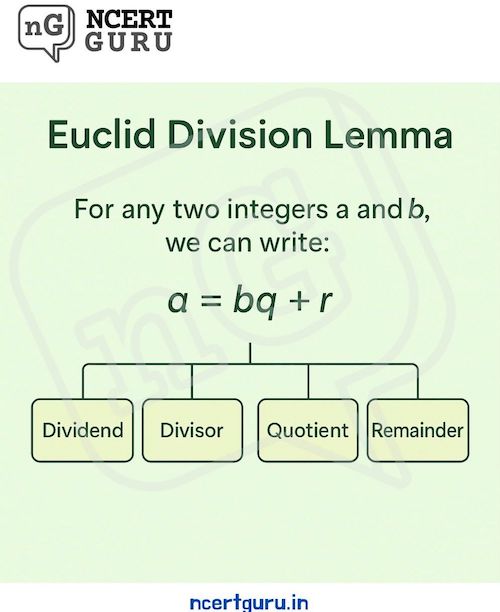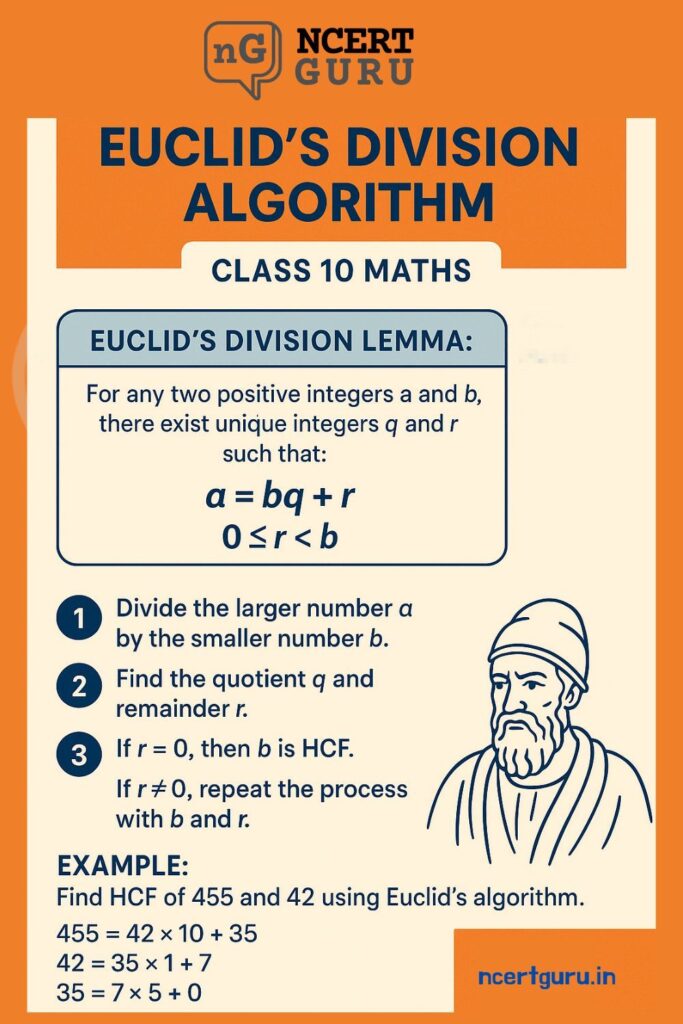In CBSE Class 10 Mathematics, Euclid Division Lemma plays a vital role in understanding real numbers and number theory. This simple yet powerful idea forms the foundation for important topics such as HCF (Highest Common Factor), GCD (Greatest Common Divisor), and prime factorization.
What is the Euclid Division Lemma?
The Euclid Division Lemma is a statement about positive integers and how they divide each other. It says:
For any two positive integers a and b, there exist unique integers q and r such that:a=bq+r,where0≤r<ba=bq+r,where0≤r<b
Here,
- a is the Dividend,
- b is the Divisor,
- q is the Quotient, and
- r is the Remainder.
This is just a formal way to describe integer division that we use every day. It mirrors the basic formula taught early on:Dividend=(Divisor×Quotient)+RemainderDividend=(Divisor×Quotient)+Remainder

You may have seen a similar formula on GeeksforGeeks and other educational platforms when learning basic division.
Euclid’s Division Algorithm and its Importance
The Euclid Division Lemma is the heart of Euclid’s Division Algorithm, which is a step-by-step method to find the HCF (or GCD) of two numbers.
Euclid’s Division Algorithm follows this simple process:
- Apply the division lemma to two numbers to find the remainder.
- Replace the larger number with the smaller number and the smaller number with the remainder.
- Repeat the process until the remainder becomes zero.
- The last non-zero remainder is the HCF (or GCD) of the two numbers.
In short:
If you are wondering how to find HCF using Euclid’s Division Lemma, this is the perfect method.

Proof of Euclid’s Division Lemma
Let’s briefly understand why the Division Lemma proof works:
Suppose we are dividing a positive integer a by a positive integer b. According to the rules of integer division, we can always find a quotient q and a remainder r such that:a=bq+ra=bq+r
Since r must be less than b (otherwise, we could increase q by 1), and r must be greater than or equal to 0 (because we are dealing with positive integers), the lemma holds true for all integers.
This concept leads to many interesting ideas in real numbers, prime factorization, LCM, and the Fundamental Theorem of Arithmetic.
Worked Examples: Euclid’s Division Lemma Applications
Let’s understand Euclid’s algorithm examples better with a few practice problems.
Example 1: Find the HCF of 96 and 36 using Euclid’s Division Algorithm.
Solution:
- Divide 96 by 36:
96=36×2+2496=36×2+24
- Now divide 36 by 24:
36=24×1+1236=24×1+12
- Now divide 24 by 12:
24=12×2+024=12×2+0
Since the remainder is now 0, the HCF is 12.
Example 2: Check if the Division Lemma holds for 101 and 17.
Solution:
- Divide 101 by 17:
101=17×5+16101=17×5+16
- Here, 16 < 17, and the formula matches a=bq+ra=bq+r.
Thus, it satisfies the Euclid Division Lemma.
Practice Problems for Better Understanding
Here are a few practice problems you can try:
- Find the HCF of 161 and 63 using Euclid’s Division Algorithm.
- Check if 250 and 37 satisfy the division lemma.
- Find HCF of 144 and 90 with Euclid’s method.
These exercises will help you master the step-by-step algorithm for solving division and HCF-related problems.
The Euclid Division Lemma is not just a small part of your CBSE Class 10 Math syllabus but a gateway to deeper concepts in mathematical proofs, problem solving, and theorem applications. Whether you’re finding the HCF, working through integer division problems, or exploring the Fundamental Theorem of Arithmetic, understanding this lemma is essential.
See more:
